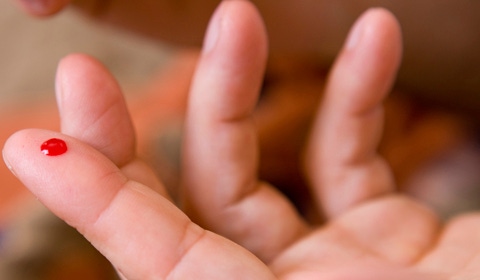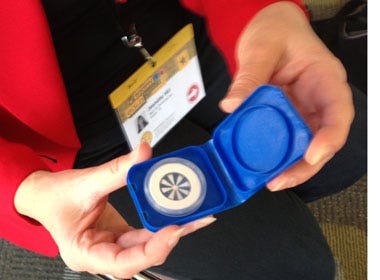Texas Startup Hopes Its Novel Device Can Remake the World of Blood Sampling
Spot on Sciences has created a device that allows anyone to give a blood sample at home.

They say everything is big in Texas.
But Spot on Sciences, a Texas startup, is intent on remaking the world of blood sampling with a nifty little blue box, the size and shape of an iPad Nano. The goal is to allow any one to draw blood at home and then create a sample that can be shipped in a stable form to any lab or other facility. This would eliminate the current method of requiring a patient to travel to a lab or doctor's office in order to have a healthcare professional draw the blood sample needed for a test. In other words, the product squarely addresses a global problem of healthcare access. Its other benefits are drawing attention from Big Pharma.
|
The HemaSpot |
Spot on Sciences uses existing technology employed to screen the blood of a newborn where the blood from the newborn's heel is transferred to a filter paper where the blood dries. A similar filter paper fans out in the shape of a wheel inside the blue box, which is called HemaSpot. Using a lancet, patients can prick their finger and put two drops of blood in the center of the box containing the filter paper which absorbs the blood. The HemaSpot box also contains a desiccant which immediately dries the blood, rendering it fit for shipping explained founder and CEO Jeanette Hill at the annual South by Southwest (SXSW) event held in Austin.
Spot on Sciences had won one of the coveted spots in SXSW's Accelerator program that allows startups in various categories like Health, Mobile, Web and others to pitch to judges for a grand prize. [Ultimately, however, an Alzheimer's diagnosis and treatment startup named Neurotrack beat its competition to win the SXSW Accelerator program in the health category.]
Dried blood technology is the basis of Spot on Sciences.
"The samples are more safe when they are dry," Hill says. "With our desiccant and once the box is closed, it keeps it very dark and very stable."
Hill developed the idea seeing the inconvenience that her elderly, diabetic mother has to endure when she has to drive 45 minutes to go give a blood sample.
The goal is to have the HemaSpot - which Hill expects would be a Class II device - available eventually at a CVS or Walgreen once an FDA clearance comes through. That, Hill hopes, will occur in the third quarter of the year along with a CE Mark in Europe.
|
The QR code at the back of the HemaSpot |
For now, the product is being sold for research purposes alone. The device also has QR code with a companion iPhone app which can contain information about the patient, as well as the date and time of the sample and the location where it was taken. That information can be used by the lab to send results back to the patient's phone and also his or her doctor.
Already, without a major marketing push, she has seen great demand for HemaSpot in places like Africa and India in the field of HIV screening. Healthcare access is a bigger problem in developing parts of the world, so it comes as no surprise that the little blue box is being requested by NGOs and HIV clinical trials groups both in the U.S. and overseas. The company is working with the South African government in HIV screening as well as with groups in Scotland for diabetes screening.
Hill won't name them but two of the top five pharma companies are also using HemaSpot in clinical trials. One of the big challenges in clinical trial recruitment is that patients need to be physically close to centers participating in the trial in order to give blood sample/
The HemaSpot removes that barrier.
"Recruitment is a huge issue especially for unusual diseases and this would be a huge bonus because it would open up the process [to people that live far away], Hill says.
This saves in recruitment costs as well. But there are other costs savings as well. Hill hopes to sell HemaSpot at retail for $12. A typical venal puncture, she says, costs between $15 and $20. Also shipping blood is expensive because it requires buying ice. HemaSpot ships it in a stable container in a dried form that requires no ice.
"Once this box is closed, it stays closed," she says. "You can drive over it with a truck. Believe me, we have done it."
By Arundhati Parmar, Senior Editor, MD+DI
Related Content
Blood Test Given in Doctor's Office May Detect Diabetes
Winning at Clinical Trials: It Takes a Lot of Patients
About the Author(s)
You May Also Like


.png?width=300&auto=webp&quality=80&disable=upscale)
